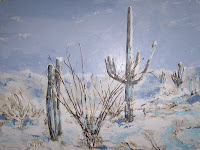
With the Getting Started section as your primer, you’re then effectively ushered through techniques on drawing and/or painting in the subsequent sections:
- Still Life and Nature
- Landscapes and Seascapes
- Buildings and Streets
- People and Portraits
- Animals and Birds
As you can see, this book runs the gamet on popular subjects that artists like to tackle.
It takes a simple approach to make you feel comfortable to accomplish what you set out to do. For example, in the Still life and Nature section, it starts you off with how to set up a still life, and after you’ve done that, it says you’re now ready to try a simple arrangement with words of encouragement and hints on what to do. In the Landscapes and Seacapes section, it schools you on drawing trees and foliage, then moves you from pencil to pen and ink to colored pencil and finally to watercolor.
It also drops in practical advice along the way, for example, a subhead in the section on Buildings and Streets tells you, “Try to capture something of the restless energy of the city in your street scenes—the ebb and flow of people going about their business, the hubbub of traffic, the color and noise.” Now that’s something that most how-to-draw books have never told you.
In People and Portraits, usually a challenge for beginning artists, you are eased into it with a discussion about proportions and measuring, which is key. It shows you ways to go about drawing the human figure, figures in action, and the head, for example. It also suggests you, “get into the habit of carrying a pocket sketchbook around with you,” always good advice. It then gives you practice sessions in doing portraits using pencil, pastels, and watercolor.
All in all, a very good book on learning to draw and paint. What makes it different from others of this type is its emphasis on the subject of what you’re drawing rather than tools.
Cheers!
No comments:
Post a Comment